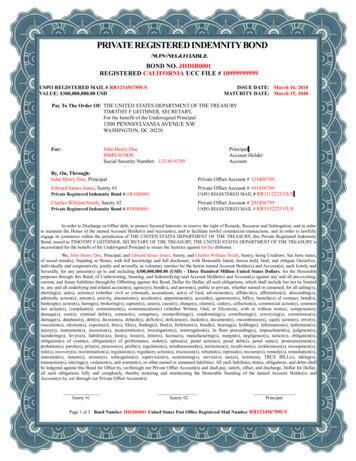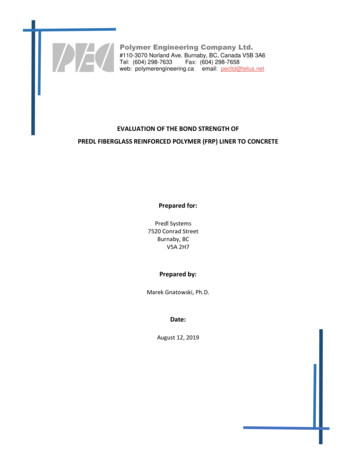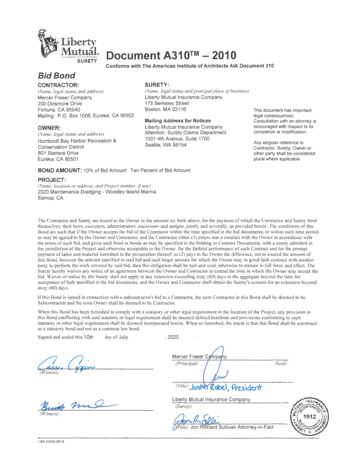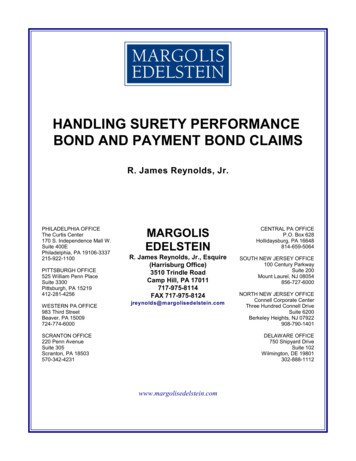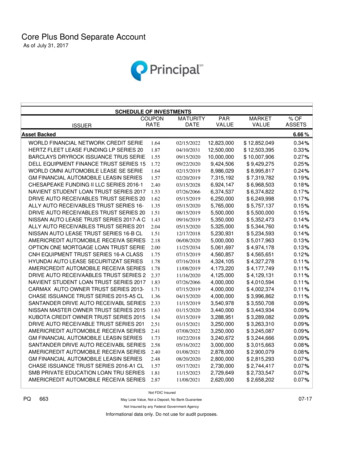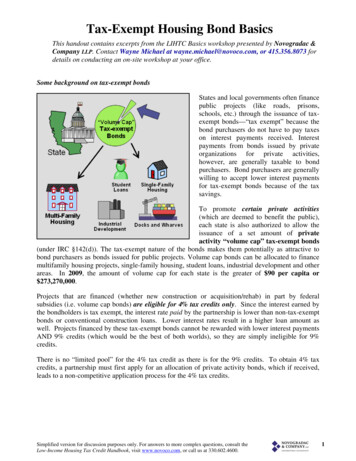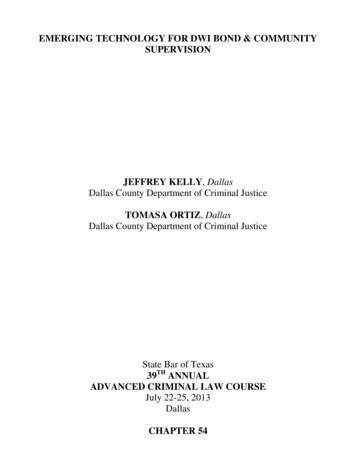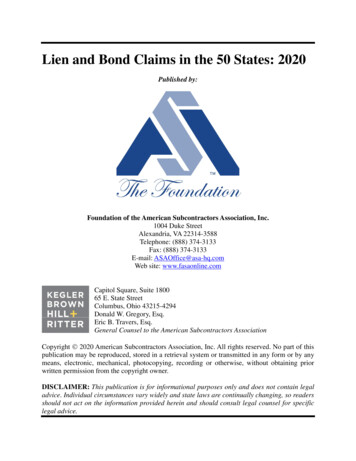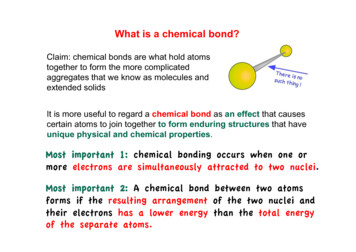
Transcription
What is a chemical bond?Claim: chemical bonds are what hold atomstogether to form the more complicatedaggregates that we know as molecules andextended solidsIt is more useful to regard a chemical bond as an effect that causescertain atoms to join together to form enduring structures that haveunique physical and chemical properties.Most important 1: chemical bonding occurs when one ormore electrons are simultaneously attracted to two nuclei.Most important 2: A chemical bond between two atomsforms if the resulting arrangement of the two nuclei andtheir electrons has a lower energy than the total energyof the separate atoms.
What is a molecule?A molecule is an aggregate of atoms that possessesdistinctive observable propertiesA more restrictive definition distinguishes between a "true" moleculethat exists as an independent particle, and an extended solid that can onlybe represented by its simplest formula.chemical species is defined by its structure.The structure of a molecule is specified by the identity of its constituentatoms and the sequence in which they are joined together, that is, by thebonding connectivity. This, in turn, defines the bonding geometry— thespatial relationship between the bonded atoms.structural formulas reveal the very different connectivitiesbond anglebond length
Some parameters of the geometrical structure of moleculesbond lengthbond angleaveragedMolecules are not static!3
Bond energy: the amount of work that must be done topull two atoms completely apart; in other words, it is thesame as the depth of the “well” in the potential energy curve.This is almost, but not quite the same as the bonddissociation energy actually required to break the chemicalbond; the difference is the very small zero-point energy,related to bond vibrational frequencies.Potential energy curvesThe energy of a system of two atomsdepends on the distance betweenthem. At large distances the energy iszero, meaning “no interaction”. Atdistances of several atomic diametersattractive forces dominate, whereas atvery close approaches the force isrepulsive, causing the energy to rise.
Concept of Potential Energy SurfacesE E(R1,R2,R3 )RA – coordinates of atom A
Chemical bondChemical reaction: connecting, rearranging of atomschemical bond: an effect that causes atoms to be joined in astructurescientific model:a tool to explain investigated phenomenaa tool to predict propertiesof moleculesModels of chemical bondingclassicalquantum-mechanical
Classical models of chemical bondingIn essence - electrostatic considerations- ionicbondcovalent bondig Walther Kossel, 1915, GermanKFK F-Gilbert Newton Lewis,1916, USAF2[Ar] [Ne]electron configurationof noble (rare) gasesδ-polarcovalentδ FF
models of the chemical bondThe ionic modelElectrolytic solutions contain ions havingopposite electrical charges; oppositecharges attract, so perhaps thesubstances from which these ions comeconsist of positive and negatively chargedatoms held together by electrostaticattraction.this is not true generally, but a model built on this assumption does afairly good job of explaining a rather small but important class ofcompounds that are called ionic solids.
Ionic bonds – When the complete transfer of one ormore electrons from one atom to another takes placegenerating charged species that are held together byelectrostatic interactions.Na(g) Na (g) e-Energy required 494kJmol-1Cl(g) e- Cl-(g)Energy released 349kJmol-1net change: 494 – 349 145kJ mol-1.Increase in energy and hence no inducement for NaCl to form.Na (g) Cl-(g) NaCl (s) Energy released 787 kJ mol-1net change: 145 – 787 -642 kJ mol-1.This is a huge decrease in energy a solid composed of Na and Cl- ions has a lower energy than does a collection of Naand Cl atoms.
Increasing ionisation energy
Shared-electron (covalent) modelThis model originated with the theory developed by G.N.Lewis in 1916, and it remains the most widely-used modelof chemical bonding. It is founded on the idea that a pair ofelectrons shared between two atoms can create a mutualattraction, and thus a chemical bond.Usually each atom contributes one electron (one of its valence electrons)to the pair, but in some cases both electrons come from one of the atoms.lone pair
Covalent bond - Lewis modelShared electron pair – a unit of the covalent bondH.HH:HH–HNumber of shared electron pairs – valencyH(1s)1H–C NC [He](2s)2 (2p)2valency: H: 1N [He](2s)2 (2p)3C: 4N: 3non-bonding (lone) electron pairLewis (electronic) structural formulas
(8-electron) octet rulevalence electron configuration of noble gases– exceptionsrule not alwaysappropiate[He] with d and forbitals thevalency isincreased- hypervalence 1 electron
ResonanceO3148 pm O-O and 121 pm O OExperiment O-O: 128 pmresonant structures
MulMplebondstriplesingledouble O OO eCr:::::CrRCrCrR(R os,etal.
Covalent bond - Lewis modeldoes not explain the nature of „bonding“ orbitals„implicitly“ works with localized (unchanged) atomicorbitalsLimitation to two-center bondsdoes not explain the geometric structure of molecules16
Lewis model does not explain the structure!VSEPR model – 1960 Ronald GillespieValence-Shell Electron-Pair RepulsionRegions of high electron densitybondlone pairrule: multiple bond is a single regionrule: any of the resonant structures can be usedgeometric structure is determined by the repulsionof these regions!
VSEPR structuresOblasti sregionsvysokouwithhighdensittieshustotoumost mídabypiramidal6oktaedrickéoctahedral18
Predicting the shapes of molecules withgeneral formula AXnEm-Repulsion: LP-LP LP-BP BP-BP-Lone pairs occupy the largest site (e.g. equatorial in atrigonal bipyramid)-If all sites are equal (e.g. octahedral geometry) thenlone pairs will be trans to each other (i.e. forming a180 angle)-Double bonds occupy more space than single bonds Bonding pairs to electronegative substituents occupyless space than those to more electropositivesubstituents.
AX3EOOHAX2E2HHHtrigonal (bent)
Why atomic orbitals don't work for moleculesBonding in beryllium hydrideConsider how we might explain thebonding in a compound of divalentberyllium, such as beryllium hydride,BeH2. The beryllium atom, with onlyfour electrons, has a configuration of1s22s2. Note that the two electronsin the 2s orbital have opposite spinsand constitute a stable pair that hasno tendency to interact withunpaired electrons on other atoms.
The only way that we can obtain two unpaired electrons forbonding in beryllium is to promote one of the 2s electronsto the 2p level. However, the energy required to producethis excited-state atom would be sufficiently great todiscourage bond formation. It is observed that Be doesform reasonably stable bonds with other atoms. Moreover,the two bonds in BeH2 and similar molecules arecompletely equivalent; this would not be the case if theelectrons in the two bonds shared Be orbitals of differenttypes, as in the "excited state" diagram above.These facts suggest that it isincorrect to assume that thedistribution of valence electronsthat are shared with other atomscan be described by atomic-types, p, and d orbitals at all.
Theory of hybrid orbitals (1928-)Linus Pauling (USA, 1901-1994)Most known american chemist of 20th century,Nobel prize: for chemistry 1954, for peace 1962hybrid orbitals- principleatomic orbitalsdo combineif s, p, d orbitals occupied by thevalence electrons of adjacentatoms are combined in a suitableway, the hybrid orbitals that resultwill have the character anddirectional properties that areconsistent with the bondingpattern in the molecule.
What are hybrid orbitals?we will look at a model that starts out with the familiar valence-shellatomic orbitals, and allows them to combine to form hybrid orbitalswhose shapes conform quite well to the bonding geometry thatwe observe in a wide variety of molecules.orbital:region of space around the nucleus in which theprobability of finding the electron exceeds somearbitrary value, such as 90% or 99%.Orbitals of all types are mathematical functions that describeparticular standing-wave patterns that can be plotted on a graph buthave no physical reality of their own. Because of their wavelikenature, two or more orbitals (i.e., two or more functions ψ) can becombined both in-phase and out-of-phase to yield a pair of resultantorbitals which, to be useful, must have squares that describe actualelectron distributions in the atom or molecule.
Constructing hybrid orbitals: Hybrid orbitals are constructed by combining theψ functions for atomic orbitals. Because wave patterns can combine both constructively and destructively, a pair of atomic wave functions such as the s- and porbitals shown at the left can combine in two ways, yielding the sp hybrids shown.2psp2s2s 2p -2s-sp2p2s-2p- -25
Covalent bond as an overlap of atomic and/orhybrid orbitals – valence bond theoryeffective overlapatom Batom AEABEAEBEv EAB-EA-EBenergy of covalent bond, bonding energykJ/mol,eV x .102 kJ/mol26
Bond energies in kJ/mole
Covalent bond as an overlap of atomic and/orhybrid orbitals – valence bond theoryatom Batom Aone-electron bond H2atom Bel. pairatom Avacant orb.acceptordonordonor-acceptor bond28
Energy standpointNotice here that 1) the total number of occupied orbitals isconserved, and 2) the two sp hybrid orbitals areintermediate in energy between their parent atomic orbitals.
In terms of plots of the actual orbital functions ψ we canrepresent the process as follows:The probability of finding the electron at any location isgiven not by ψ, but by ψ2, whose form is roughlyconveyed by the solid figures in this illustration.Digonal bonding: sp-hybrid orbitals
Hybrids derived from atomic s- and p orbitalsTrigonal (sp2) hybridizationThe molecule has plane trigonal geometry.
Hybrids derived from atomic s- and p orbitalsTetrahedral (sp3) hybridizationseveral tetravalent moleculesIn the ground state of the freecarbon atom, there are twounpaired electrons in separate2p orbitals. In order to form fourbonds (tetravalence), need fourunpaired electrons in fourseparate but equivalent orbitals.We assume that the single 2s,and the three 2p orbitals ofcarbon mix into four sp3 hybridorbitals which are chemically andgeometrically identical
Bonding with hybrid orbitals
Lone pair electrons in hybrid obitalsIf lone pair electrons are present on the central atom, these canoccupy one or more of the sp3 orbitals. This causes the moleculargeometry to be different from the coordination geometry, whichremains tetrahedral.ammonia
Structure: trigonal bipyramidsp3d (dsp3) hybrid orbitalsIf the energies of s, p, d are closes px py pz dz² (n)5 (sp3d)ClP v PCl5sp3dP:PCl5dsp33s3p3ddz² (n-1) s px py pz35
The shape of PCl5 and similarmolecules is a trigonal bipyramidsp3d hybridsWith lone (non-bonding) pairs:
Structure:: octahedronsp3d2 (d2sp3) hybrid orbitalsIf the energies of s, p, d are closes px py pz dx²-y² dz² (n)SF6(n-1)F6 (sp3d2)6 (d2sp3)S in SF6sp3d2S:3s3p3d37
Octahedral coordinationsix electron pairs will try to point towardthe corners of an octahedrontwo square-based pyramidsjoined base to basetransition metal2332sp d / d spcomplexesSF6with lone pairsFe(H2O)63
d3s, sd3: tetrahedrondsp2, sp2d: squaredx²-y² s px py[PtCl4]2–dsp2Pt2 Pt5d6s6pVSEPR fails!39
The molecular orbital modelThis model takes a more fundamentalapproach by regarding a molecule as acollection of valence electrons and positivecores. Just as the nature of atomic orbitalsderives from the spherical symmetry of theatom, so will the properties of these newmolecular orbitals be controlled by theinteraction of the valence electrons with themultiple positive centers of these atomiccores.These new orbitals, unlike those of the hybrid model, are delocalized;that is, they do not “belong” to any one atom but extend over the entireregion of space that encompasses the bonded atoms.
Theory of molecular orbitals (MO)local orbitalsglobal orbitalsMO-LCAOLinear Combination of Atomic OrbitalsMOψiNAO Σ cmiφmm 1i 1,Na number – weight (importance)of m-th AO in i-th MOelectrons are not „localized“Epithio-cycloallinmulti-center, delocalized bonds41
ψiN Σ cmiφmm 1i 1,NMaximum as many MOs as AOs!discrete energy levels for ψi (MO)equal energy for different ψidegenerate orbitalsdegeneracyAufbau principle analogic to atomsPauli principle and Hund rule, as well42
Molecular orbitals in two-atomic molecules- -σ*antibonding MO*Energy sA-sBsAMO energysB diagramσbonding MO atom A sA sB atom B43
Molecular orbital diagramsBond order is defined as the differencebetween the number of electron pairsoccupying bonding and nonbondingorbitals in the molecule.
Sigma and pi orbitalsσ orbitals are cylindrically symmetric with respect to the line of centersof the nucleirather thanbeingrotationallysymmetricabout the lineof centers,these orbitals extend in both perpendicular directions from this line ofcenters. Orbitals having this more complicated symmetry are called π (pi)orbitals. There are two of them, πy and πz differing only in orientation, butotherwise completely equivalent. Nodal plane along the bond!
Types of covalent bonds, molecular orbitals– symmetry considerationsσ bond – circular � bond – single nodal planealong the bondxy-x yxz-xzyz-yzd-d46
Types of covalent bonds, molecular orbitals– symmetry considerationsd-dδ bond – 2 nodal plainsalong the bondφ bond –3 nodal plainsalong the bondf-f47
Molecular orbitals in two-atomic moleculesatom A- -pAz atom Bσ*-pBzπxy πypxA pxB pA -sBpAz -pBz--σσ*-σπx*y πy*pxA - pxB - - - -zz pAx s B-04
structural formulas reveal the very different connectivities bond length bond angle . Some parameters of the geometrical structure of molecules bond length bond angle Molecules are not static! averaged 3 . Bond energy: the amount of work that must be done to pull two atoms completely apart; in other words, it is the same as the depth of the “well” in the potential energy curve. This is .

